
India's rice production can adapt to climate change challenges: Study
text_fieldsAccording to a new study by the University of Illinois, adopting different strategies to grow rice can help increase productivity and mitigate climate change.
Rice being the primary crop in India, is planted on a wide scale but traditional farming of rice using rice transplants requires plenty of water.
However, the study has shown that using direct-seeded rice instead of transplants can increase production while using significantly less water.
The research, published in the journal 'Water', was conducted at the Borlaug Institute for South Asia's research farm in Bihar, India. The study aimed to estimate rice yield and water demand by 2050 and evaluate how farmers can adapt to the effects of climate change.
The researchers collected data on rice yield and climate conditions, which were then used to model future scenarios based on four global climate models with the help of computer simulations.
According to the United Nations' Food and Agriculture Organization (FAO), the world population is expected to rise to 2 billion people by 2050, which will increase the food demand by 60 per cent.
Traditional rice farming involves the flooding of fields and is usually done in areas that receive heavy rainfall, and when done with rice transplants, the fields requires about six inches of standing water. In case the surfaces of the fields are not even, even more water is needed to cover the crops. Approximately 4000 litres of water is used up in the production and processing of one kilogram of rice.
"As the weather changes, it affects temperature, rainfall, and carbon dioxide concentration. These are essential ingredients for crop growth, especially for rice. It's a complicated system, and the effects are difficult to evaluate and manage," said researcher Prasanta Kalita, Professor at the University of Illinois in the US.
Based on the estimation of FAO, about 30 per cent of the crops are either lost or wasted after the harvest. The research also pointed out that efforts must be taken to prevent the post-harvest loss of crops so that food security is achieved and the 60 per cent increase in food demand by 2050 is reached while minimizing the additional irrigation needs.
Switching from rice transplants to direct-seeded rice, keeping the crop residue on the ground to preserve water, preventing immediate drying up of soil and post-harvest loss of crops are measures recommended by the study to reduce the use of water and increase the yield of the crop.






